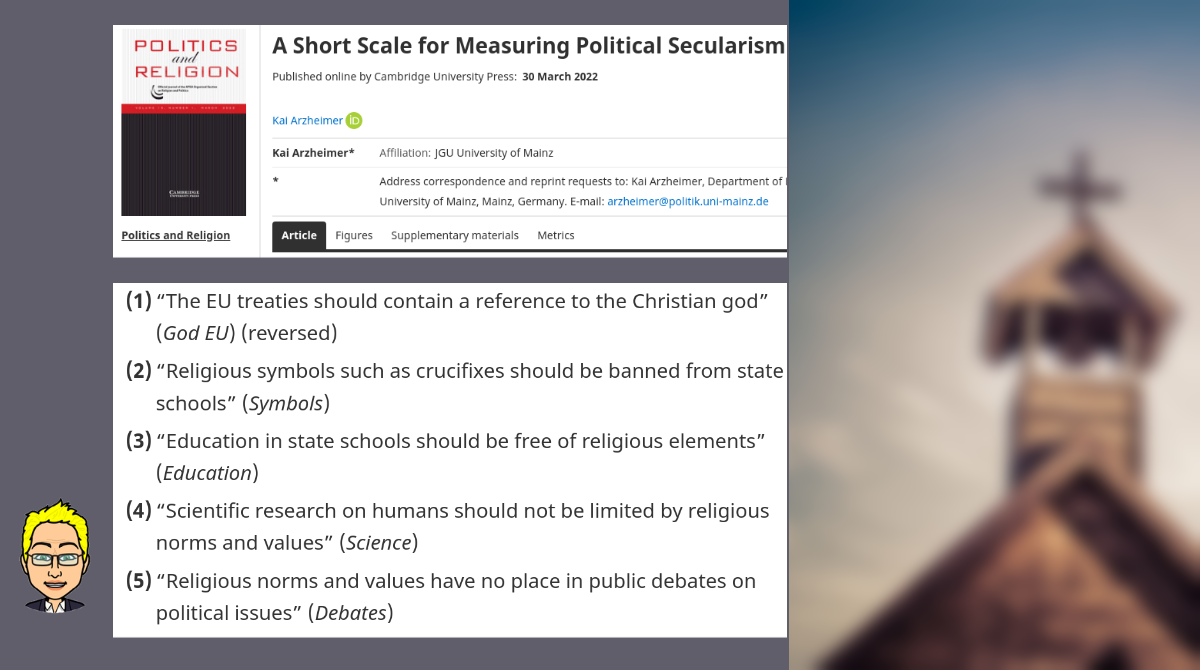For better (seriously?) or worse (you betcha!), politics and religion are intimately intertwined. While everyone and their grandfather (and especially their grandfather) gets worked up about immigration from Muslim-majority countries, the more relevant development in much of Europe is secularisation.
Secularisation as a process has many facets (e.g. a decline of religious membership, practice, and beliefs). From a political and political science POV, the rise of political secularism is a particularly interesting aspect of it.
As an ideology, political secularism is well researched. But while there is a plethora of instruments for measuring religiousness, there is no instrument for measuring individual politically secular attitudes. These are not two sides of the same coin. Political secularism is not merely the absence of religiousness, but rather a world view which holds that religious beliefs should play no role in politics.
- Arzheimer, Kai. “A short scale for measuring political secularism.” Politics and Religion 15.4 (2022): 827-840. doi:10.1017/S1755048322000104
[BibTeX] [Abstract] [Download PDF] [HTML] [DATA]As religiousness is declining across democracies, scientific interest in secular orientations and their political implications is growing. One specific and particularly important aspect of secular attitudes is political secularism. Political secularism is not merely the absence of religiousness, but rather a world view which holds that religious beliefs should play no role in politics. While there are hundreds of survey instruments that measure the strength and content of religiousness, there is no comparable measure that taps into political secularism. In this research note, I briefly review the concept of political secularism and present a cluster of items which target it. Utilising data from four large population representative samples taken in the eastern and western states of Germany, I use Confirmatory Factor Analysis to show that these items form a short but internally consistent scale. This scale also displays convergent and discriminant validity. It may be readily used in future surveys.
@Article{arzheimer-2022, author = {Arzheimer, Kai}, title = {A short scale for measuring political secularism}, journal = {Politics and Religion}, year = 2022, volume = {15}, number = {4}, pages = {827-840}, abstract = {As religiousness is declining across democracies, scientific interest in secular orientations and their political implications is growing. One specific and particularly important aspect of secular attitudes is political secularism. Political secularism is not merely the absence of religiousness, but rather a world view which holds that religious beliefs should play no role in politics. While there are hundreds of survey instruments that measure the strength and content of religiousness, there is no comparable measure that taps into political secularism. In this research note, I briefly review the concept of political secularism and present a cluster of items which target it. Utilising data from four large population representative samples taken in the eastern and western states of Germany, I use Confirmatory Factor Analysis to show that these items form a short but internally consistent scale. This scale also displays convergent and discriminant validity. It may be readily used in future surveys.}, dateadded = {22-12-2021}, doi = {10.1017/S1755048322000104}, url = {https://www.cambridge.org/core/services/aop-cambridge-core/content/view/21DBFFEAB1631615697BBC3CC5FD5128/S1755048322000104a.pdf/a-short-scale-for-measuring-political-secularism.pdf}, data = {https://doi.org/10.7910/DVN/XEKNYW}, html = {https://www.kai-arzheimer.com/scale-political-secularism}, }
In a new publication (of which I am unduly proud), I present a short battery of items that tap into politically secular attitudes. Making use of data from four large representative surveys, I use Confirmatory Factor Analysis to show that these items form an internally consistent scale. I also demonstrate convergent and discriminant validity of this scale. To use the technical term, it’s a neat, short instrument that may be readily used in future surveys.

The article came out today in Politics & Religion (after a wait of almost Catholic proportions). It is published as Open Access under a Creative Commons licence. Replication data are also freely available, and if that is not enough, there is a lengthy appendix with even more tables. And here is my celebratory twitter thread 👇.
Discover more from kai arzheimer
Subscribe to get the latest posts sent to your email.


Which is why wishy-washy liberals are no match for religious nutters. Bring back old-school leftist parties, I say.
But politically secular persons tend towards tolerance, religious not. Seculars therefore tend towards more middle and religious people towards more absolute positions